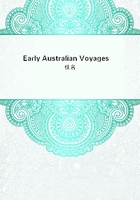
第24章
On the 25th, in the latitude of 4 degrees 35 minutes south, and in the longitude of 175 degrees 10 minutes, we found the variation 9 degrees 30 minutes east. We were then in the height of the islands of Mark, which were discovered by William Schovten and James le Maire. They are fourteen or fifteen in number, inhabited by savages, with black hair, dressed and trimmed in the same manner as those we saw before at the Bay of Murderers in New Zealand. On the 29th we passed the Green Islands, and on the 30th that of St. John, which were likewise discovered by Schovten and Le Maire. This island they found to be of a considerable extent, and judged it to lie at the distance of one thousand eight hundred and forty leagues from the coast of Peru. It appeared to them well inhabited and well cultivated, abounding with flesh, fowl, fish, fruit, and other refreshments. The inhabitants made use of canoes of all sizes, were armed with slings, darts, and wooden swords, wore necklaces and bracelets of pearl, and rings in their noses. They were, however, very intractable, notwithstanding all the pains that could be taken to engage them in a fair correspondence, so that Captain Schovten was at last obliged to fire upon them to prevent them from making themselves masters of his vessel, which they attacked with a great deal of vigour; and very probably this was the reason that Captain Tasman did not attempt to land or make any farther discovery. On April 1st, we were in the latitude of 4 degrees 30 minutes south, and in the longitude of 171 degrees 2 minutes, the variation being 8 degrees 45 minutes to the east, having now sight of the coast of New Guinea; and endeavouring to double the cape which the Spaniards call Cobo Santa Maria, we continued to sail along the coast which lies north-west. We afterwards passed the islands of Antony Caens, Gardeners Island, and Fishers Island, advancing towards the promontory called Struis Hoek, where the coast runs south and south-east. We resolved to pursue the same route, and to continue steering south till we should either discover land or a passage on that side.
It is necessary to observe, that all this time they continued on the coast, not of New Guinea but of New Britain, for that cape which the Spaniards called Santa Maria is the very same that Captain Dampier called Cape St. George, and Caens, Gardeners, and Fishers Islands all lie upon the same coast. They had been discovered by Schovten and Le Maire, who found them to be well inhabited, but by a very base and treacherous people, who, after making signs of peace, attempted to surprise their ships; and these islanders managed their slings with such force and dexterity, as to drive the Dutch sailors from their decks; which account of Le Maire's agree perfectly well with what Captain Dampier tells us of the same people. As for the continent of New Guinea, it lies quite behind the island of New Britain, and was therefore laid down in all the charts before Dampier's discovery, at least four degrees more to the east than it should have been.